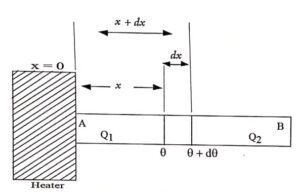The heat which is flowing along the length of the bar (linearly) is called linear heat flow or rectilinear heat flow.

Let us consider two parallel planes perpendicular to the x axis and at a distance x and x+δx from the hot end. Let θ be the excess of temperature at the plane x and ![]() be the temperature gradient.
be the temperature gradient.
where K is the coefficient of thermal conductivity and A is the area of cross section of the bar.
![Rendered by QuickLaTeX.com \begin{aligned} \mathrm{Q}_{2} & =-\mathrm{KA} \frac{\mathrm{d}}{\mathrm{d} x}\left(\theta+\frac{\mathrm{d} \theta}{\mathrm{d} x} \cdot \delta x\right) \\ & =-\mathrm{KA}\left[\frac{\mathrm{d} \theta}{\mathrm{d} x}+\frac{\mathrm{d}^{2} \theta}{\mathrm{d} x^{2}} \delta x\right] \end{aligned}](https://pedagogyzone.com/wp-content/ql-cache/quicklatex.com-959eaae217ae0d494457315f66322cfb_l3.png)
So the net amount of heat gained per second by the element of thickness δx, sandwitched between the two planes will be
![Rendered by QuickLaTeX.com \begin{aligned} \mathrm{Q} & =\mathrm{Q}_{1}-\mathrm{Q}_{2}=-\mathrm{KA} \frac{\mathrm{d} \theta}{\mathrm{d} x}-\left[-\mathrm{KA}\left(\frac{\mathrm{d} \theta}{\mathrm{d} x}+\frac{\mathrm{d}^{2} \theta}{\mathrm{d} x^{2}} \delta x\right)\right] \\ & =\mathrm{KA} \frac{\mathrm{d}^{2} \theta}{\mathrm{d} x^{2}} \delta x \end{aligned}](https://pedagogyzone.com/wp-content/ql-cache/quicklatex.com-0deb0f230579e283d9bb8e5b50fce23e_l3.png)
Before the steady state is reached
The quantity of heat Q is used in two ways before the steady state is reached. Partly the heat is used to raise the temperature of the road and the rest is lost due to radiation.
Let the rate of rise of temperature of the bar be dθ/dt. The heat used per second to raise the temperature of the rod = mass x specific heat × (increase in temperature/time).
Where A is the area of cross section, ρ is the density, and S is the specific heat of the material of the rod.
The heat lost per second due to radiation =Epδxθ
Where p is the perimeter, E is the emissive power of the surface and θ is the average excess of temperature of the rod between the planes A and B.
![]()
Substituting for Q from relation – (3) we get
eqn (7)

The above relation is the general that represents the rectilinear flow of heat along the bar of uniform area of cross section.
| Read More Topics |
| Experimental verification of compton effect |
| Heat flow through a compound media or wall |
| Characteristics of De-Broglie waves |





